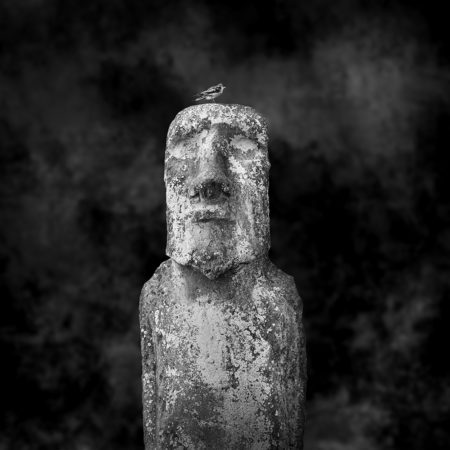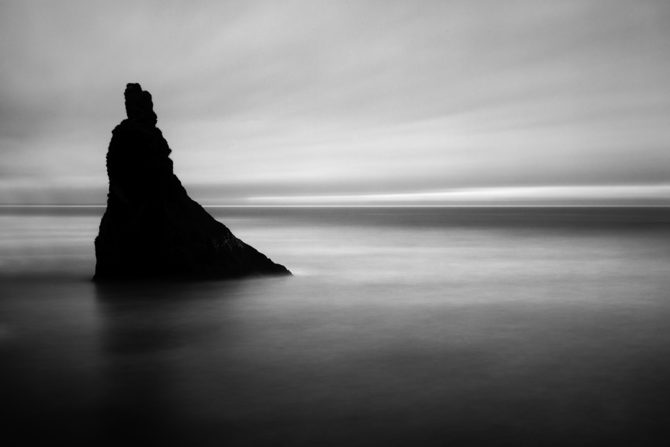Tag: moai
March 17, 2019
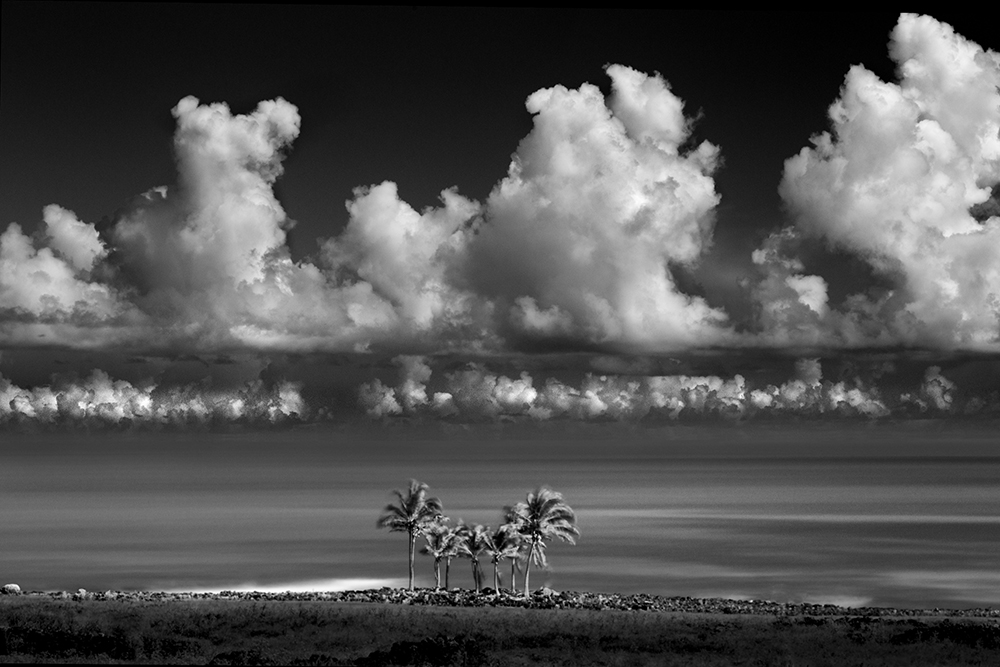
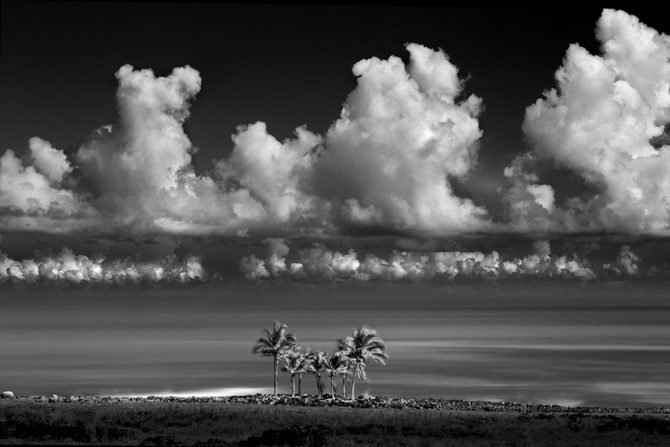
Palms, Rapa Nui
A photographer friend, George Digalakis, asked me to write this article for his blog: Inspirational Places. You can read the original article here: https://www.digalakisphotography.com/inspirations/ct-ei
My Favorite Location:
How does one choose their favorite location? It would be like choosing your favorite image or favorite child!
Sometimes it seems like the last location is always my favorite location. And philosophically, I don’t believe an exotic location should be necessary for creating a great image. My philosophical hero, Edward Weston, said the following when he was confined to a chair with Parkinson’s:
I should be able to look down at my feet and see something to photograph
But I have been fortunate to travel to many incredible locations. And of all the places I’ve been, Easter Island has been the most significant to me. Why? Because it has been on my mind ever since I read Thor Heyerdahl’s book “Aku Aku” when I was 17 years old.
Now fast forward 47 years to when my wife and I were compiling our bucket list and I mentioned that I’d love to add Easter Island to the list, but that it really wasn’t feasible. My wife asked: why not? I didn’t really have an answer and so off we went in 2015.
Easter Island is known as the world’s most isolated inhabited place. I tell people that it’s really not that hard to get to, but it isn’t for the faint of wallet. It’s an expensive journey.
Easter Island is small, about 7 by 15 miles and has about 5500 inhabitants, some of which are the native Rapa Nui and also many Chileans. Only the Rapa Nui can own land on Easter Island.

Easter Island is best known for its Moai, those monolithic statues carved by the ancients. There are about 1000 Moai on the island and about 30 standing on several different ahu’s or alters.
I spent two weeks there, circumnavigate the island 3-5 times each day. I focused almost exclusively on the Moai and created three portfolios:
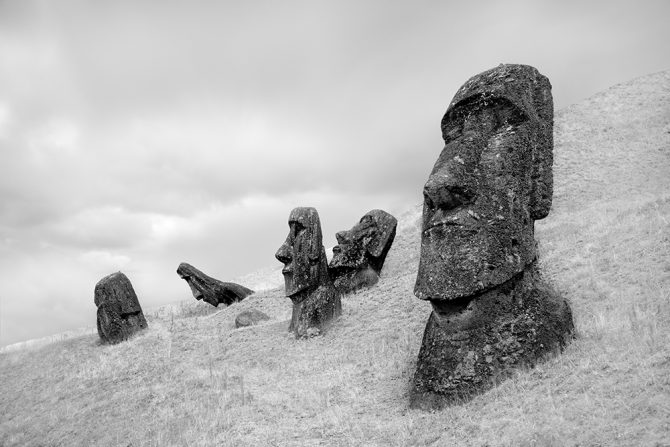
The Moai of Rano Raraku
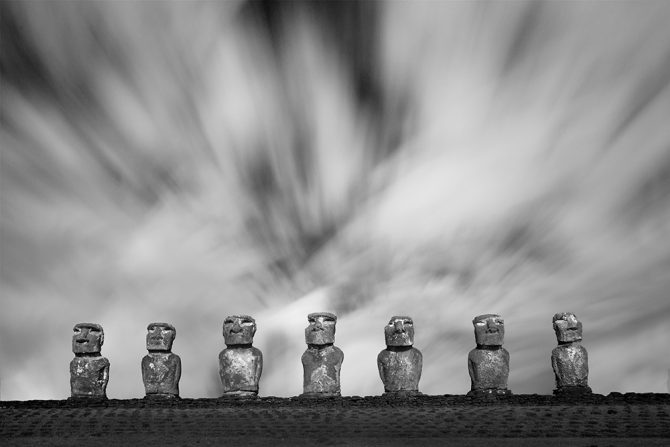
Standing Moai
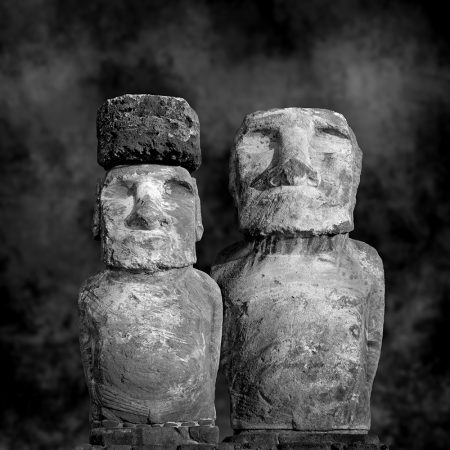
Moai, Sitting for Portrait
The portfolio I am most proud of is the “Moai, Sitting for Portrait” and how it came about. Here is my artist statement:
In January of 2015 I spent two weeks photographing the Moai of Easter Island. This fulfilled a lifelong dream, one that started when I was 17 and read the book “Aku Aku” by Thor Heyerdahl. I became fascinated with the Moai and they have been on my mind and influenced my art for these many years.
As I traveled to Easter Island and tried to imagine what I would encounter, something interesting happened: I fell asleep and dreamt that I had invited the Moai to come and sit for a formal portrait.
When I awoke I thought “why not?”
I knew there would be challenges: the Moai are reserved, aloof and almost unapproachable. They had suffered greatly at the hands of outsiders and the question was: would they come to trust me?
Distance was the first hurdle to be overcome: the island is small by automobile standards, but when we are talking about the Moai who walk everywhere, traversing the island to get to my makeshift studio could be difficult. Then there was the Moai’s physical condition: many were incapacitated by war and the ravages of time and could not make the journey. And how would I accommodate the size of the Moai, with some towering 33 feet tall?
Facing these challenges and armed with nothing more than a dream and hope, I issued the invitations…but would they come?
Initially only a few came; the younger and less suspicious ones. But slowly, as word spread of their experience, others started to arrive.
Photographing the Moai created some interesting situations: one older Moai refused to allow me to photograph his face and turned his back on the camera. Another arrived with a hawk and insisted on having his portrait taken with the bird atop his head. Several Moai with bullet wounds, inflicted by outsiders, insisted that I document those scars.
And there were tense moments, as two rival Moai came together face-to-face in the studio, but which ended well when they agreed to be photographed together. And there were touching moments as old friends were reunited after years of separation.
The Moai are quiet, stoic and could even been described as “stone-faced.” And it’s true, not once was I able to photograph a Moai smiling, but instead they have a dignified poise that transcends time.
It was a lifelong dream that brought me to Easter Island and a sleeping dream that caused me to create this portfolio.
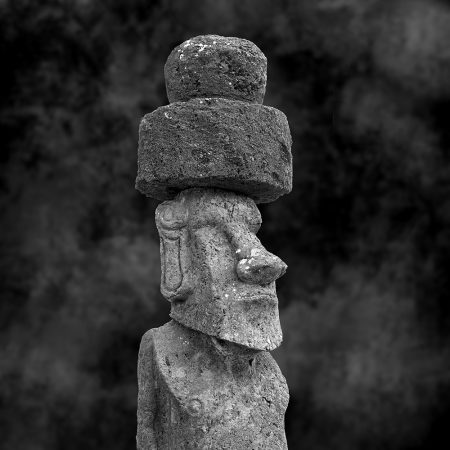
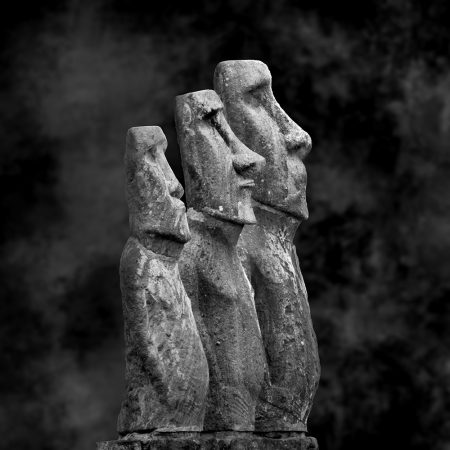
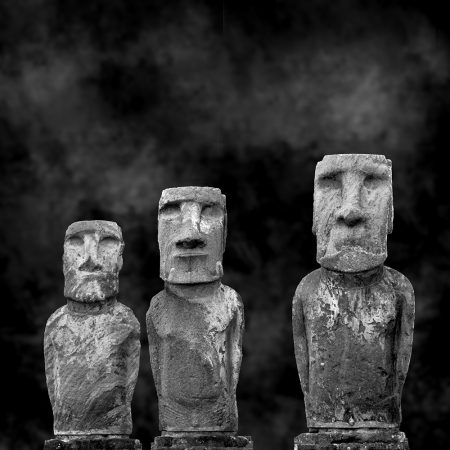
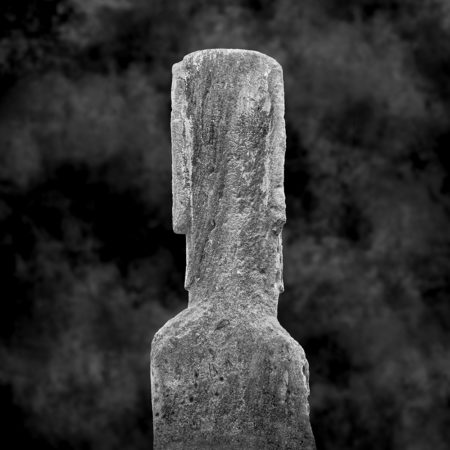
See all of the Moai portraits here
June 14, 2017
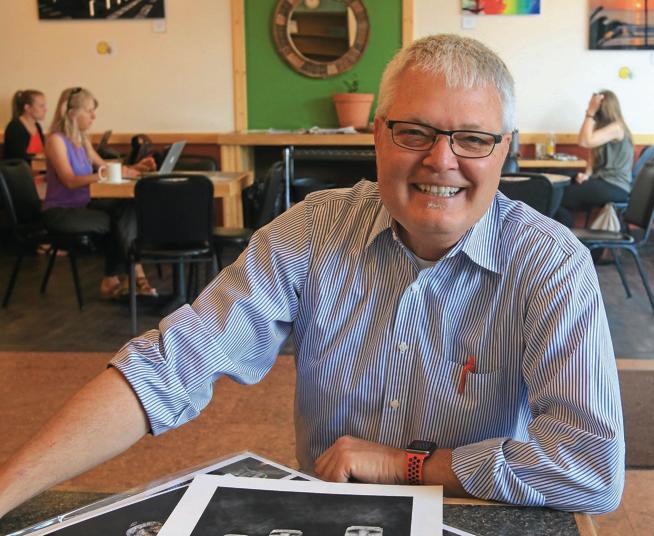
Photographer travels the world to capture black-and-white images
Cole Thompson work on display at Lincoln Gallery in June
By Kenneth Jessen
For the Reporter-Herald
POSTED: 06/14/2017 10:04:18 AM MDT
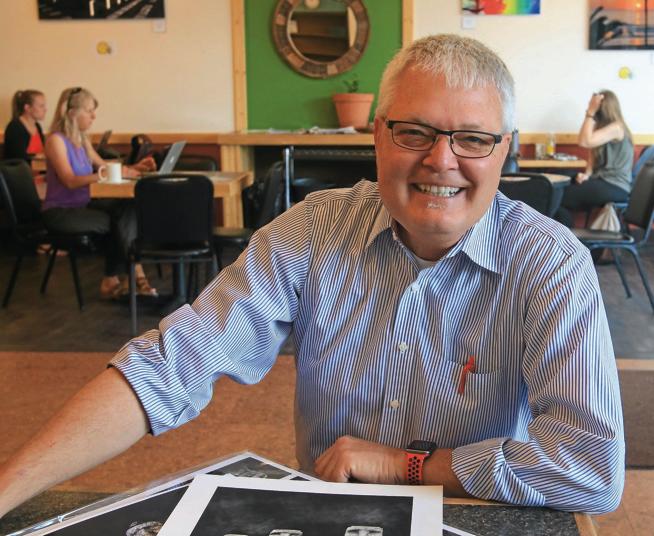
Photographer Cole Thompson enjoys the creative process. His “Moai Sitting for Portraits,” shot on Easter Island, will be on display for the month of June at the Lincoln Gallery. (KENNETH JESSEN / Loveland Reporter-Herald)
Read the full article here:
Cole
P.S. My thanks to Ken for such a nice article!
P.P.S. My special thanks for Ken for getting me to smile, I NEVER smile in photographs!
May 14, 2017
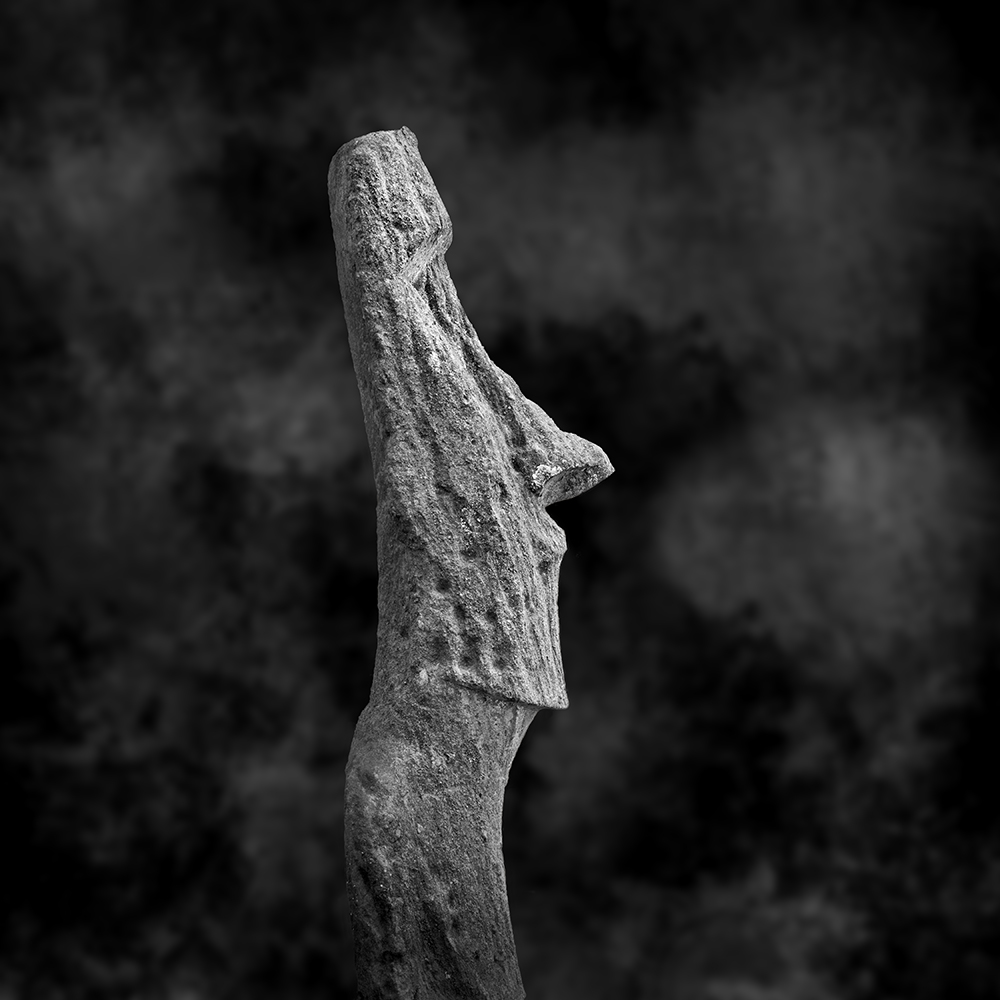

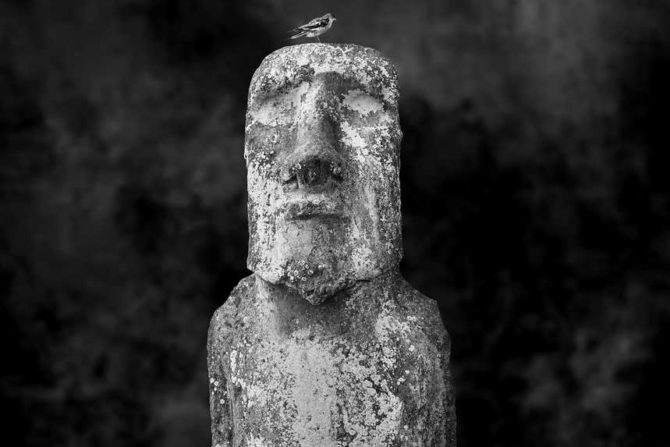
My “Moai, Sitting for Portrait” series will be featured at the Lincoln Gallery in Loveland, CO for the month of June with an opening reception on June 9th.
Here is the artist statement for this series:
In January of 2015 I spent two weeks photographing the Moai of Easter Island. This fulfilled a lifelong dream, one that started when I was 17 and read the book “Aku Aku” by Thor Heyerdahl. I became fascinated with the Moai and they have been on my mind and influenced my art for these many years.
As I traveled to Easter Island and tried to imagine what I would encounter, something interesting happened: I fell asleep and dreamt that I had invited the Moai to come and sit for a formal portrait.
When I awoke I thought “why not?”
I knew there would be challenges: the Moai are reserved, aloof and almost unapproachable. They had suffered greatly at the hands of outsiders and the question was: would they come to trust me?
Distance was the first hurdle to be overcome: the island is small by automobile standards, but when we are talking about the Moai who walk everywhere, traversing the island to get to my makeshift studio could be difficult. Then there was the Moai’s physical condition: many were incapacitated by war and the ravages of time and could not make the journey. And how would I accommodate the size of the Moai, with some towering 33 feet tall?
Facing these challenges and armed with nothing more than a dream and hope, I issued the invitations…but would they come?
Initially only a few came; the younger and less suspicious ones. But slowly, as word spread of their experience, others started to arrive.
Photographing the Moai created some interesting situations: one older Moai refused to allow me to photograph his face and turned his back on the camera. Another arrived with a hawk and insisted on having his portrait taken with the bird atop his head. Several Moai with bullet wounds, inflicted by outsiders, insisted that I document those scars.
And there were tense moments, as two rival Moai came together face-to-face in the studio, but which ended well when they agreed to be photographed together. And there were touching moments as old friends were reunited after years of separation.
The Moai are quiet, stoic and could even been described as “stone-faced.” And it’s true, not once was I able to photograph a Moai smiling, but instead they have a dignified poise that transcends time.
Here are the exhibition details:
The Lincoln Gallery, 429 N. Lincoln Ave, Loveland, CO
Opening Reception: Friday, June 9th from 6 – 9 pm
Artist Talk: Friday, June 9th at 6:30 pm
If you are in the area, I hope to see you there!
Cole
January 28, 2016
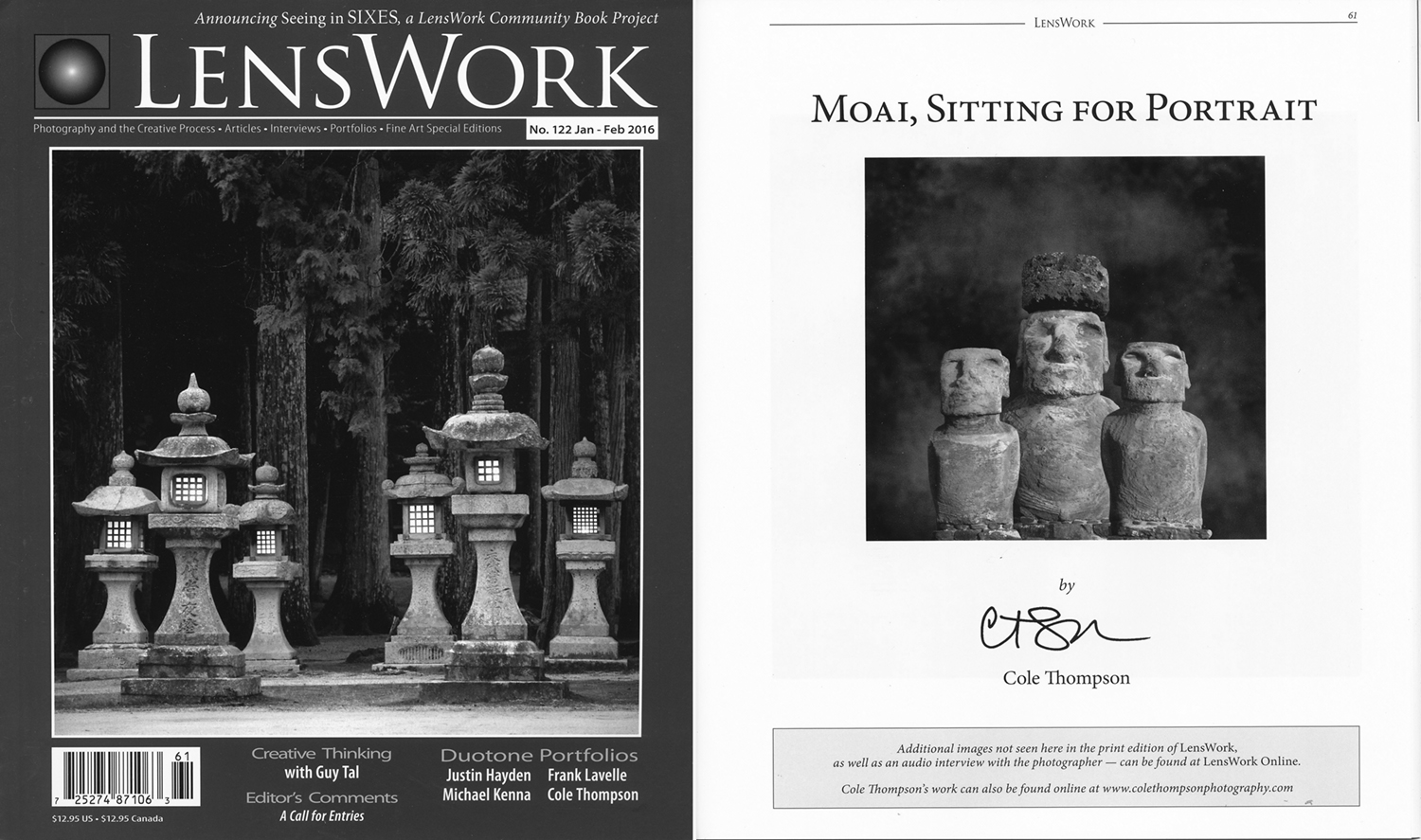
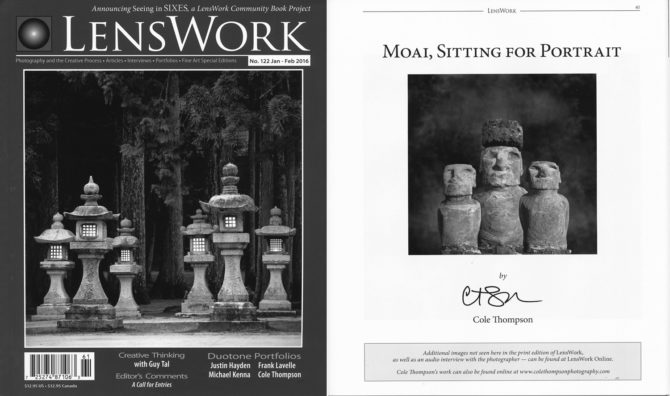
I’m honored to have my portfolio “Moai, Sitting for Portrait” featured in the January/February 2016 issue of LensWork.
This is my fifth body of work to be featured and I’m very proud of that because I consider this to be the highest honor my work could receive. I respect this publication very much.
If you’re not familiar with LensWork, it is in my opinion the finest black and white publication available. The quality of the photography is matched only by the quality of the printing. It is simply worlds above any other magazine.
You can subscribe to LensWork or pick up a copy at Barnes and Noble. If you’d like a signed copy, I’d be happy to send you one for $10.
Cole
March 26, 2015
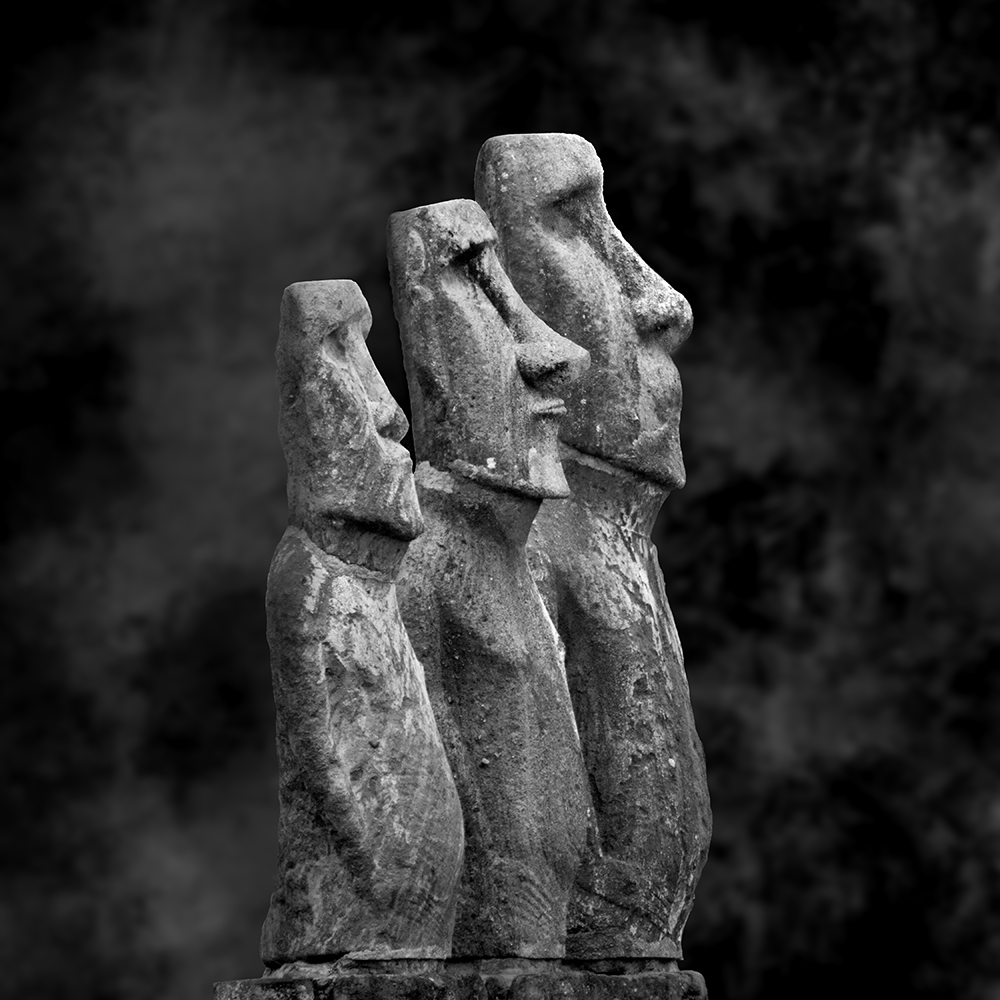
Set the video to 720 for a better viewing experience!
March 13, 2015
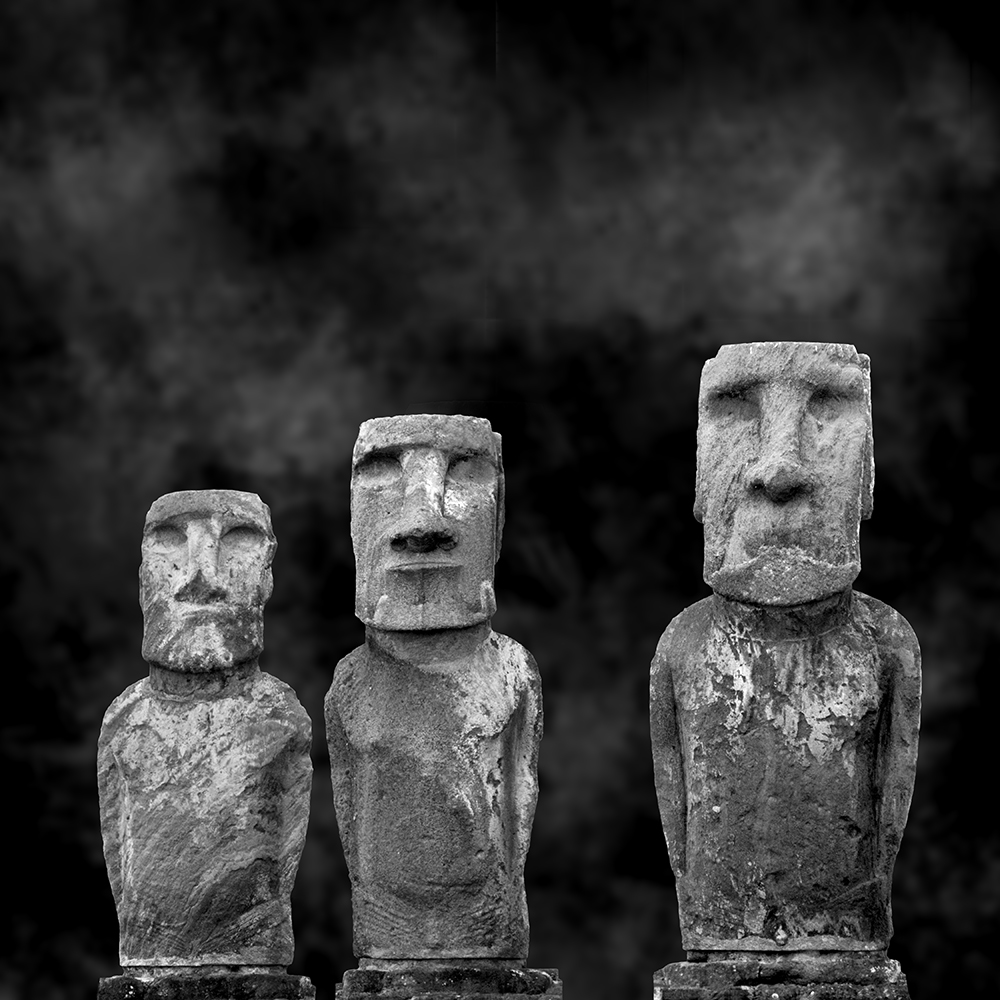
Let met start at the beginning: It was 1967 and I had borrowed the book Aku Aku from my high school teacher, friend and mentor, John Holland. This is how I was introduced to the Moai of Easter Island.
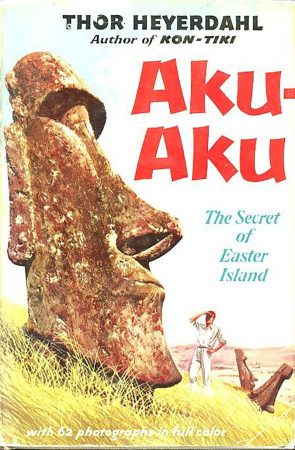
I became fascinated with the Moai and would spend hours and hours trying to imagine how and why they were built and even more perplexing: why they stopped? Even though this was my only “contact” with the them, they have been on my mind these many, many, many (you get the idea) years.
And interestingly, I have always imagined the Moai as being living beings.
Fast forward to 2014: I am planning my next photography trip and discussing with my wife where I might go. Easter Island had always been on my bucket list but I never really believed that I’d be able visit due to it’s remote location. But over the next several days I began to question that assumption and a few weeks later the trip was planned.
In keeping with my Photographic Celibacy I did not look at what other photographers had done before me. I wanted my Vision to be pure and unsullied by the ideas and Vision of others. However this approach has some disadvantages: what if I created work that was similar to what others had done, simply because I didn’t know what others had done?
I was willing to take that risk and proceeded blindly.
My trips are never planned, I simply go to a location, wander about and trust that something will inspire me. However this can cause great anxiety if I don’t find something that sparks an idea quickly and I start to worry that I’ll come home empty handed. I’ve had that happen to me several times before but fortunately something always seems to capture imagination and passion.
As we flew to Easter Island I like a child on Christmas eve, wondering what gifts I would find in the morning. And as I wondered what the morning would bring I fell asleep and dreamt, I dreamt that I had met the Moai and invited them to come to my studio to sit for a formal portrait…and they did!
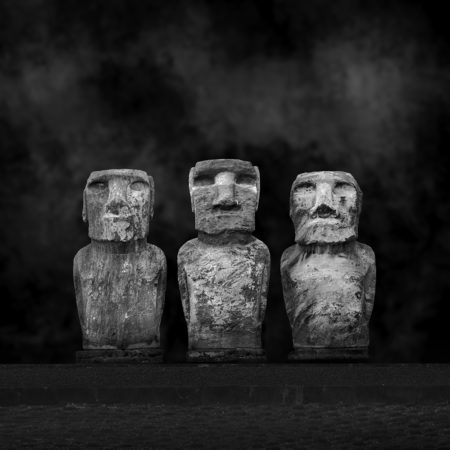
When I awoke I thought to myself, why not? I had always thought of them as being alive and I would create studio portraits of them as though they were. This idea really got me excited, as excited as I’d ever been for a project. It just seemed like a natural for me!
I was certainly out of my depth in several areas: I have no portrait experience, I could not control the lighting and I had never done anything this complex in Photoshop before. But a lack of skills has never stopped me before and instead I viewed it as a challenge.
In my mind I laid out my plan of action: I would photograph the Moai as though they were sitting in my studio, a tight shot and at appropriate angles. I’d try to catch them in diffused light and later I’d try to make it look like studio lighting. And lastly I’d outline the Moai and drop them into a digital backdrop that I would create.
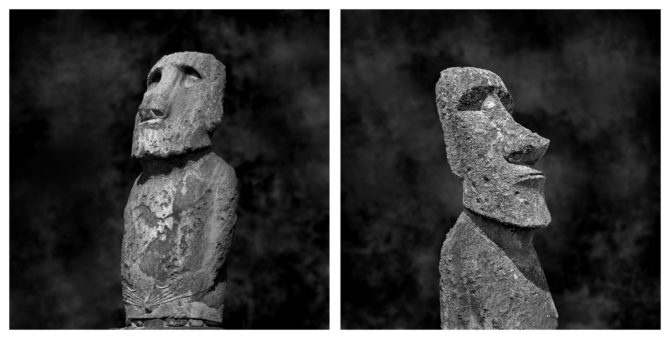
I had to get the shots right because I had only one chance at this. I took a huge number of photographs from every angle and vantage point I could think of. I followed the sun and each morning went to one side of the island and each afternoon I went to other. Because I was looking for subdued light and could not control what I got, I had to wait for many hours at each location for a cloud to pass overhead.
Once home I started off by creating a portrait background for my Moai. I then blurred it to give the image a shallow depth of field and a three dimensional look. Later when I looked at all of the images as a group, the background looked redundant and so I created several slightly different versions to break things up a bit.
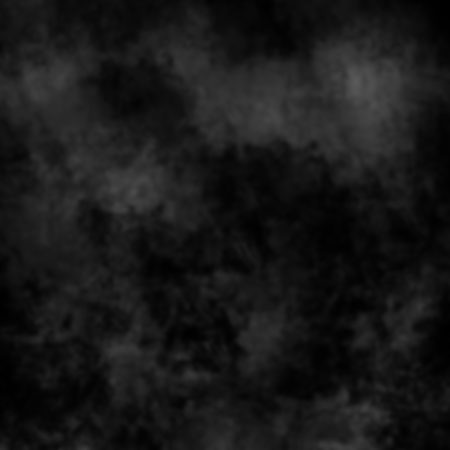
Next I needed to learn how to outline the Moai. I was very fortunate to be working with objects that had hard edges which made the outlining much easier. A great deal of this work had to be done manually at 300% magnification because the Moai’s background interfered with some of the more automatic methods of selection. This is where a tablet really shines, I simply could not have done this outlining with a mouse!
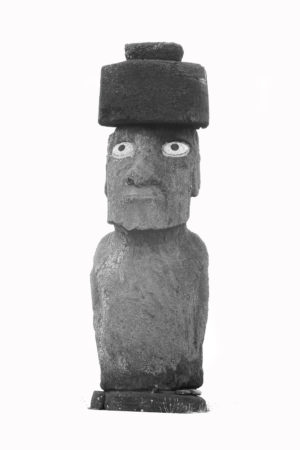
Next I pasted the outlined Moai into the background but felt that it looked unnatural. I learned that an object looks “pasted in” when the edges of the object are sharper than the object itself. So I took a 3 pixel blur tool and manually blurred the edge of the Moai at 300% magnification.
Then came the lighting: how could I make the lighting look as though the Moai had been lit in a studio? With no lighting experience, I simply experimented with dodging and burning, trying to make the light source appear to come from a particular direction.
With a small amount of practice I found I could bring a Moai to this point in about an hour. But the final refining of the image is what took the longest.
I would let the images sit for a week and then would come back to see them with a fresh eye. On the first pass I was unhappy with the lighting and modified it quite a bit; lessening the directional lighting effect and opening up the shadows more. I let it sit for another week and tweaked some more. And then I repeated this a third and fourth time until there were no more changes.
Here are a couple “before and after” images to show you the original shot and the final image.
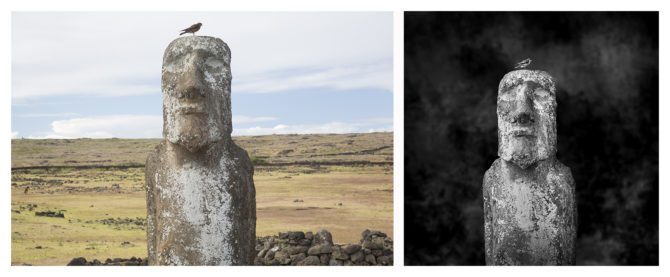
Outlining was easy when the Moai were against the sky and I could use the automatic methods of selection. But when the background was cluttered as in the lower half of this one, I had to manually outline.

When I shot this image I was not thinking portraits, but these first three Moai on the left worked out perfectly anyway.
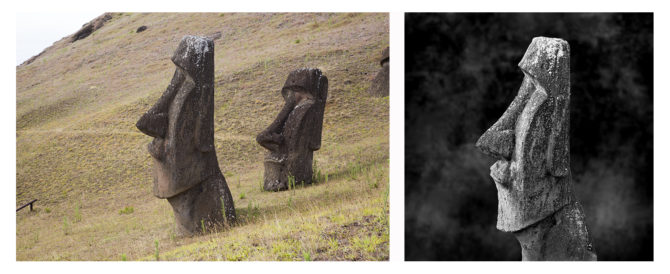
The images from the quarry were harder to put into the studio because they were photographed against the grass. I had to stay on designated paths and that limited my choice of angles and consequently the background. These images were completely hand outlined and often I had to clone out the weeds that were in the way.
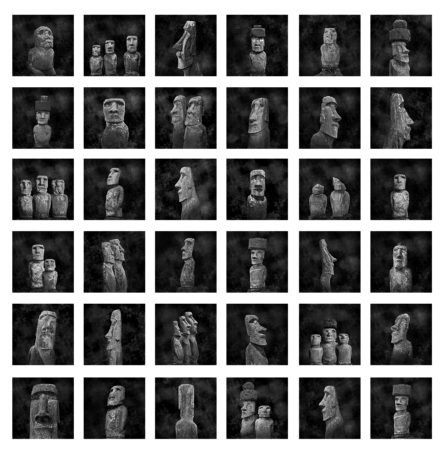
In the end I created forty portraits of the Moai and I love them. The trip was a wonderful adventure in itself, but to pursue a project that treated the Moai as though they were alive, really was dream come true.
This project reinforced three of my guiding principles as a fine art photographer:
1. I must pursue a project that I am passionate about and have a Vision of.
2. Skills come second to Vision. If I don’t have the skills, I can always learn the them.
3. I must create for myself and love what I’ve created.
Cole
P.S. You can see the full portfolio here: http://www.colethompsonphotography.com/MoaiSittingForPortrait.htm
March 6, 2015

In January of 2015 I spent two weeks photographing the Moai of Easter Island. This fulfilled a lifelong dream, one that started when I was 17 and read the book “Aku Aku” by Thor Heyerdahl. I became fascinated with the Moai and they have been on my mind and influenced my art for these many years.
As I traveled to Easter Island and tried to imagine what I would encounter, something interesting happened: I dreamt that I had invited the Moai to come and sit for a formal portrait.
When I awoke I thought “why not?”
I knew there would be challenges: the Moai are reserved, aloof and almost unapproachable. They had suffered greatly at the hands of outsiders and the question was: would they come to trust me?
Distance was the first hurdle to be overcome: the island is small by automobile standards, but when we are talking about the Moai who walk everywhere, traversing the island to get to my makeshift studio could be difficult. Then there was the Moai’s physical condition: many were incapacitated by war and the ravages of time and could not make the journey. And how would I accommodate the size of the Moai, with some towering 33 feet tall?
Facing these challenges and armed with nothing more than a dream and hope, I issued the invitations…but would they come?
Initially only a few came; the younger and less suspicious ones. But slowly, as word spread of their experience, others started to arrive.
Photographing the Moai created some interesting situations: one older Moai refused to allow me to photograph his face and turned his back on the camera. Another arrived with a hawk and insisted on having his portrait taken with the bird atop his head. Several Moai with bullet holes inflicted by outsiders insisted that I document those scars.
And there were tense moments, as two rival Moai came together face-to-face in the studio, but which ended well when they agreed to be photographed together. And there were touching moments as old friends were reunited after years of separation.
The Moai are quiet, stoic and could even been described as “stone-faced.” And it’s true, not once was I able to photograph a Moai smiling, but instead they have a dignified poise that transcends time.
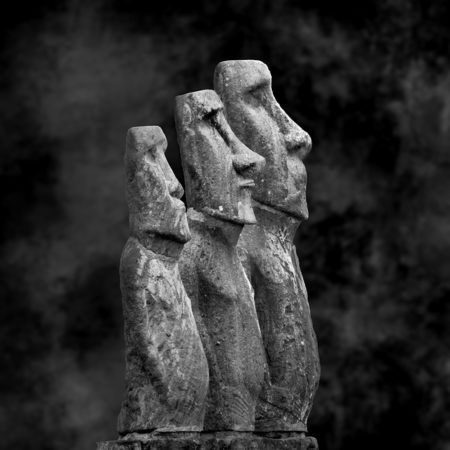
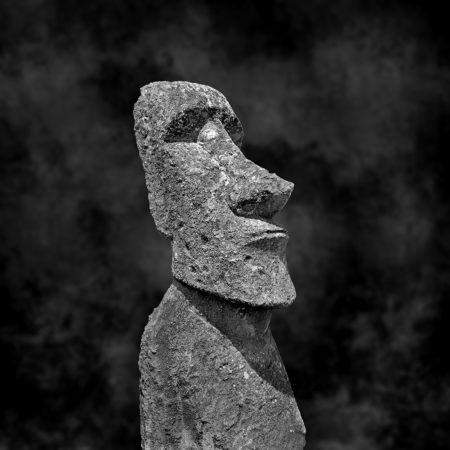

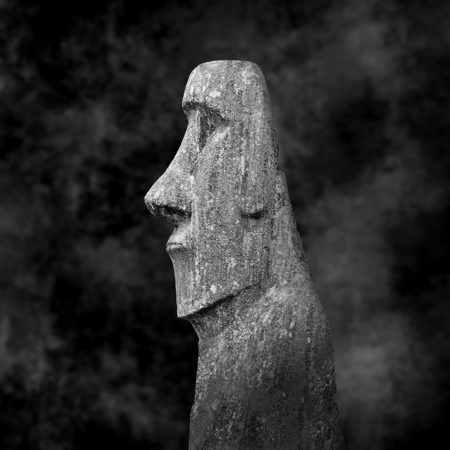
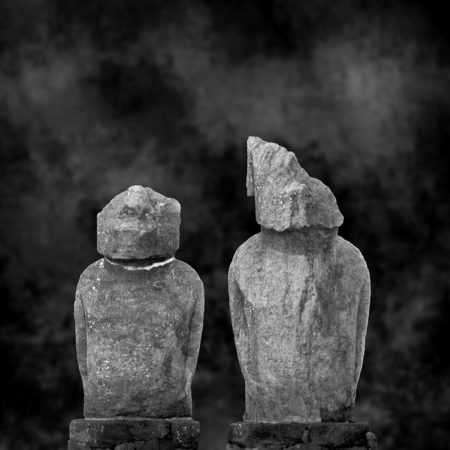

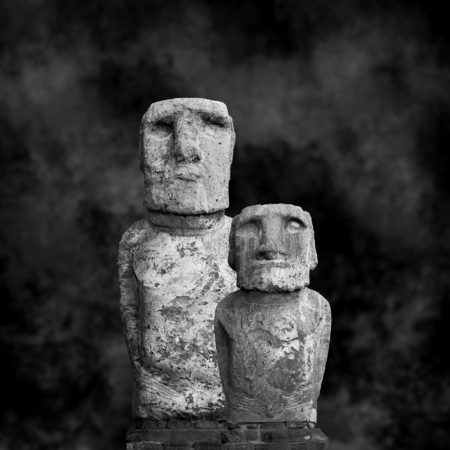
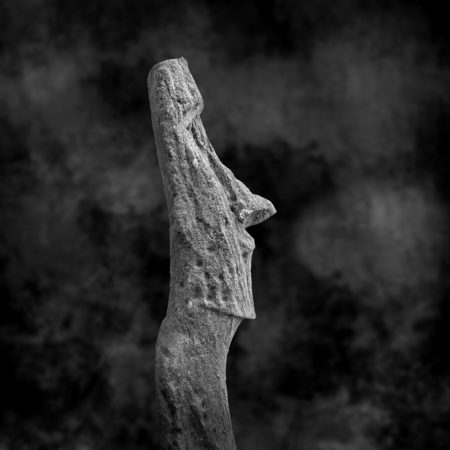
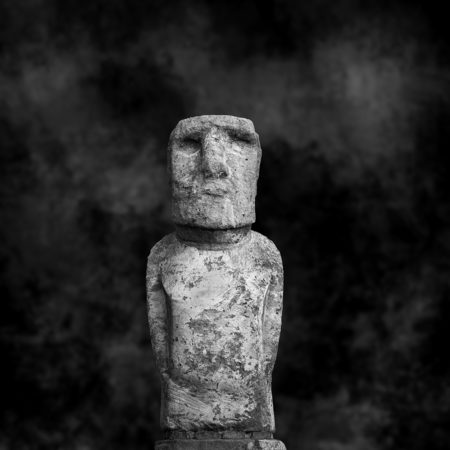
December 26, 2014
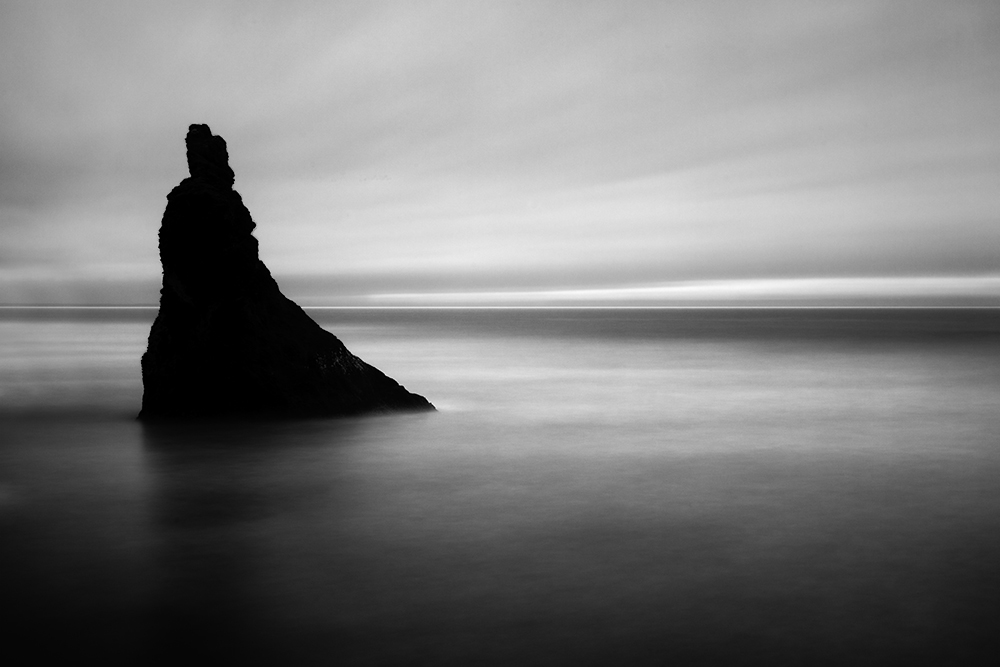
Monolith No. 33
I’m heading out for Easter Island Sunday morning and I’m both excited nervous.
Excited because I’ve wanted to visit Easter Island ever since I was 17 and read the book Aku Aku by Thor Heyerdahl. It really captured my imagination and I would dream of the Moai and those unknown peoples who created them. Going to Easter Island has long been a dream of mine.
But I’m also nervous because when I go on a trip like this I worry that I’ll come home empty handed and not meet people’s expectations. And each time someone says “I can’t wait to see what you get!” I become even more apprehensive.
And the more apprehensive I get, the more pressure I put on myself. And the more pressure I put on myself, the less creative I am because I’m focused on what others expect and not my own Vision.
So here’s what I have learned to do, to minimize that apprehension and maximize my creativity:
First: I remind myself that I’m visiting one of the most exciting places on earth and a top destination on my bucket-list. That alone is enough to make this a successful trip, no matter what.
Second: I tell myself that if I create just one image that I love, I’ll be happy.
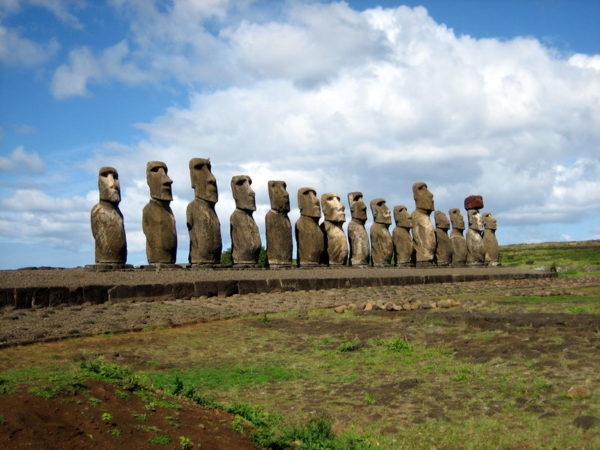
Third: I will not look at anyone else’s work from Easter Island. I do not want to have any preconceived ideas of what I should create.
Fourth: I’ll spend a lot of time alone contemplating the Moai. I am confident that if I can relax and spend time with them, my Vision will appear.
And Fifth: I will keep reminding myself that I am creating for myself and I’ll put out of my head any internal or external expectations.
What I have learned is that worrying is not only ineffective, it’s actually harmful to my creative process. I just need to relax, enjoy the trip and have faith that something will come to me.
See you in a few weeks!
Cole


